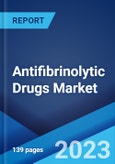The global antifibrinolytic drugs market size reached US$ 16.9 Billion in 2023. Looking forward, the publisher expects the market to reach US$ 24.2 Billion by 2032, exhibiting a growth rate (CAGR) of 4.1% during 2023-2032.
Antifibrinolytic drugs refer to the pharmaceutical medicines used for promoting the formation of blood clots to prevent fibrinolysis or blockage in arteries and veins. These drugs inhibit the activation of plasminogen, thereby preventing the lysis of fibrin and maintaining clot stability. They are used for the treatment of hemorrhages, vascular tumors and providing relief from heavy menstrual bleeding. They are also used for controlling bleeding during or after invasive surgeries. Some commonly available antifibrinolytic drugs include tranexamic acid, aprotinin, aminocaproic acid and serine protease inhibitors. They are widely used for the management of mucosal bleeding in the oropharynx, nose, gastrointestinal (GI) tract and uterine-vaginal linings. As a result, they are extensively used across hospitals, clinics and trauma and ambulatory surgical centers.
Hereditary Angioedema
Fibrinolytic Response Testing
Surgeries
Others
Injectable
Ambulatory Surgical Centers
Trauma Centers
Others
United States
Canada
Asia-Pacific
China
Japan
India
South Korea
Australia
Indonesia
Others
Europe
Germany
France
United Kingdom
Italy
Spain
Russia
Others
Latin America
Brazil
Mexico
Others
Middle East and Africa
2. What is the expected growth rate of the global antifibrinolytic drugs market during 2024-2032?
3. What are the key factors driving the global antifibrinolytic drugs market?
4. What has been the impact of COVID-19 on the global antifibrinolytic drugs market?
5. What is the breakup of the global antifibrinolytic drugs market based on the indication?
6. What are the key regions in the global antifibrinolytic drugs market?
7. Who are the key players/companies in the global antifibrinolytic drugs market?
Antifibrinolytic drugs refer to the pharmaceutical medicines used for promoting the formation of blood clots to prevent fibrinolysis or blockage in arteries and veins. These drugs inhibit the activation of plasminogen, thereby preventing the lysis of fibrin and maintaining clot stability. They are used for the treatment of hemorrhages, vascular tumors and providing relief from heavy menstrual bleeding. They are also used for controlling bleeding during or after invasive surgeries. Some commonly available antifibrinolytic drugs include tranexamic acid, aprotinin, aminocaproic acid and serine protease inhibitors. They are widely used for the management of mucosal bleeding in the oropharynx, nose, gastrointestinal (GI) tract and uterine-vaginal linings. As a result, they are extensively used across hospitals, clinics and trauma and ambulatory surgical centers.
Antifibrinolytic Drugs Market Trends:
The rising incidence of road accidents, traumas and various bleeding disorders is one of the key factors driving the growth of the market. Moreover, the widespread adoption of antifibrinolytic drugs to prevent blood loss in women suffering from menorrhagia and during cardiovascular and neurosurgeries is providing a thrust to the market growth. Antifibrinolytic drugs are essential for preventing clot lysis and minimizing blood loss. In line with this, increasing health consciousness and awareness among the masses regarding the available treatment alternatives for hereditary angioedema and hemophilia are also contributing to the growth of the market. Various technological advancements and the increasing utilization of antifibrinolytic therapy to reduce transfusion in orthopedic patients are acting as other growth-inducing factors. Pharmaceutical manufacturers are also developing innovative oral and intravenous drug variants with enhanced efficacy and bio-absorbability. Other factors, including the rising geriatric population and significant improvements in the healthcare infrastructure, are anticipated to drive the market toward growth.Key Market Segmentation:
The report provides an analysis of the key trends in each sub-segment of the global antifibrinolytic drugs market report, along with forecasts at the global, regional and country level from 2024-2032. Our report has categorized the market based on indication, form and end user.Breakup by Indication:
GynecologyHereditary Angioedema
Fibrinolytic Response Testing
Surgeries
Others
Breakup by Form:
OralInjectable
Breakup by End User:
Hospitals and ClinicsAmbulatory Surgical Centers
Trauma Centers
Others
Breakup by Region:
North AmericaUnited States
Canada
Asia-Pacific
China
Japan
India
South Korea
Australia
Indonesia
Others
Europe
Germany
France
United Kingdom
Italy
Spain
Russia
Others
Latin America
Brazil
Mexico
Others
Middle East and Africa
Competitive Landscape:
The competitive landscape of the industry has also been examined along with the profiles of the key players being ACIC Pharmaceuticals Inc., Akorn Inc., Aurobindo Pharma Limited, Ferring Pharmaceuticals, Novartis AG, Pfizer Inc., Takeda Pharmaceutical Company Limited, Viatris Inc. and Vitruvias Therapeutics Inc.Key Questions Answered in This Report
1. How big is the global antifibrinolytic drugs market?2. What is the expected growth rate of the global antifibrinolytic drugs market during 2024-2032?
3. What are the key factors driving the global antifibrinolytic drugs market?
4. What has been the impact of COVID-19 on the global antifibrinolytic drugs market?
5. What is the breakup of the global antifibrinolytic drugs market based on the indication?
6. What are the key regions in the global antifibrinolytic drugs market?
7. Who are the key players/companies in the global antifibrinolytic drugs market?
Table of Contents
1 Preface3 Executive Summary11 Value Chain Analysis13 Price Analysis
2 Scope and Methodology
4 Introduction
5 Global Antifibrinolytic Drugs Market
6 Market Breakup by Indication
7 Market Breakup by Form
8 Market Breakup by End User
9 Market Breakup by Region
10 SWOT Analysis
12 Porters Five Forces Analysis
14 Competitive Landscape
List of Figures
List of Tables
Companies Mentioned
- ACIC Pharmaceuticals Inc.
- Akorn Inc.
- Aurobindo Pharma Limited
- Ferring Pharmaceuticals
- Novartis AG
- Pfizer Inc.
- Takeda Pharmaceutical Company Limited
- Viatris Inc.
- Vitruvias Therapeutics Inc.
Methodology

LOADING...
Table Information
| Report Attribute | Details |
|---|---|
| No. of Pages | 138 |
| Published | July 2024 |
| Forecast Period | 2023 - 2032 |
| Estimated Market Value ( USD | $ 16.9 Billion |
| Forecasted Market Value ( USD | $ 24.2 Billion |
| Compound Annual Growth Rate | 4.1% |
| Regions Covered | Global |
| No. of Companies Mentioned | 9 |









